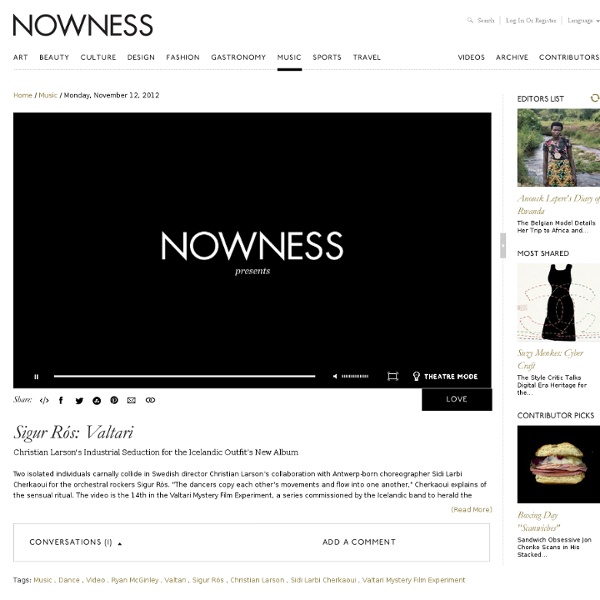Sigur Rós: Valtari

Demon Days: Alvin Leung
Amid tentacles and open flames, the self-professed “Demon Chef” Alvin Leung reveals a wicked palate and a penchant for carnal creations in this short by filmmaker Ryan Hopkinson. Born in London and raised in Toronto, Leung rose to prominence in Hong Kong, becoming known for what he calls “X-treme Chinese” cuisine, a far-out technique that harnesses the futuristic appeal of molecular gastronomy alongside the wide reach of fusion. The incendiary results both morph traditional Chinese recipes into kinky culinary experiences, and tackle off-the-plate issues: the self-taught chef’s signature dish, Sex on the Beach, serves up an edible “condom” on a shitake beach, created to raise funds and awareness for AIDS charity. Preparing to launch Bo London, an offshoot of his prominent Hong Kong Bo Innovation, set to open in Mayfair this autumn, Leung spoke to NOWNESS about the science—and the magic—behind his delectable madness. What inspires your X-treme recipes?
Arkitip, Inc.
Divine Proportions
Saudi Arabian basketball players and Qatari swimmers feature in Brigitte Lacombe’s striking portraits of Arab women in sport. Commissioned by the Qatar Museums Authority, Brigitte and her sister, the documentary filmmaker Marian Lacombe, stayed at the pre-Olympic Arab Games in Doha for ten days last December to find their subjects. Traveling extensively around the Arab world, visiting Qatar, Morocco and Saudi Arabia, Lacombe photographed athletes who were often from economically deprived or war torn countries. “The young girls and women athletes we met were spirited and full of joy,” says Lacombe. Hey’Ya: Arab Women in Sport by Brigitte Lacombe and Marian Lacombe is running at Sotheby's London from July 25 to August 11, traveling to the Q.M.A.
Tegneklubben
Break Line: Stephanie Gilmore
Slicing her way through breaking waves, professional surfer Stephanie Gilmore stars in Trestles Forever, filmed on the Pacific Ocean by NOWNESS regular Todd Cole. The 24-year-old Gilmore rose to international prominence in 2007 when she seized the Women’s World Title for the first time, an award she has regained in four of the five years since. “I love working with people from outside the world of surfing,” says the New South Wales native. “It’s so refreshing to see their take on what we do every day.” SoCal-based Cole turned to the famously ocean-adept cinematographer Sonny Miller to swim after Gilmore with a 16mm camera locked into some custom-made underwater gear and loaded with black-and-white reversal stock. Location The Trestles, San Diego County. Shoot duration One day; a few hours in the morning, then off on a boat looking for clear pools of water, and then another hour of surfing at sunset. Number of waves surfed 16. Number of surf choreographers used One: Sonny Miller.
E. St. Laurent
Blog - Please magazine | style, fashion, jewelry, culture
Beautiful/Decay Cult of the Creative Arts
Related:
Related:



